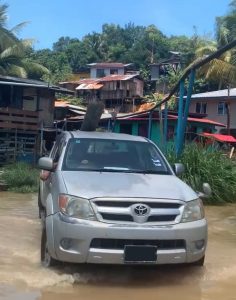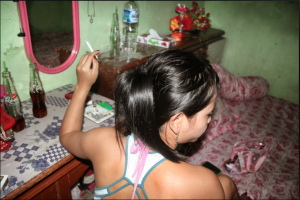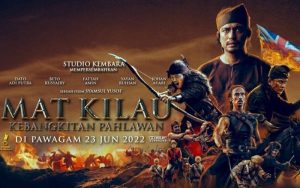 From Left to Right: Suzy, Victoria, Eleanor, Okui, Yana, Poodien and Fuad[/caption]
From Left to Right: Suzy, Victoria, Eleanor, Okui, Yana, Poodien and Fuad[/caption]
The prime objective of the project is to offer a platform for the voices of marginalized communities in which each artist is partnered with a location partner as such:
-
Eleanor representing Malaysian Borneo’s indigenous people
-
Okui with the Indonesian migrant worker community ‘Serantau’
-
Poodien with Lydia Anak Botek from the Orang Asal community in Kampung Gebok, Negeri Sembilan
-
Victoria with Madam Norzihah Kasim, a silat teacher from Gurun, Kedah
-
Yana with Madam Jane, Kwei Ling and Lean Thai who were the ex-communist guerillas of the 1970s.
The project has produced 4 installations and 1 performance which highlighted the respective communities through the marginal narratives within Malaysia’s social-political terrain. The exhibition name ‘Merata Suara’ is derived from a wordplay in Malay which can mean “to spread voices” or “to even out the voices” both of which speak to democratic aspirations; a gesture that greatly reflects the core values of this project. In the words of the Curator, “Understandably, marginal narratives exist because the grand narratives are buttressed in place. Grand narratives that catapult a national identity can only succeed by suppressing other narratives and creating a “margin” by demarcating arbitrary boundaries and drawing up territorial lines to separate us.”
[caption id="attachment_18015" align="alignleft" width="640"] ‘Welder’s Flash’ (pictured on frame below) and a live performative exhibition created by Okui Lala in collaboration with members of SERANTAU. “Perjalanan bersama Desi” (A Journey with Desi) was part of the collaborative work process between Desi and Okui, where dialogues played a key role in the process of understanding one another. 3 dialogues were recorded from this process: between Desi and Okui; Desi and Nasrikah (Leader of Serantau); Desi and Sofi (a young factory worker). Each dialogue differed in accordance with their background and relationships to each other.[/caption]
[caption id="attachment_18016" align="alignleft" width="640"]
‘Welder’s Flash’ (pictured on frame below) and a live performative exhibition created by Okui Lala in collaboration with members of SERANTAU. “Perjalanan bersama Desi” (A Journey with Desi) was part of the collaborative work process between Desi and Okui, where dialogues played a key role in the process of understanding one another. 3 dialogues were recorded from this process: between Desi and Okui; Desi and Nasrikah (Leader of Serantau); Desi and Sofi (a young factory worker). Each dialogue differed in accordance with their background and relationships to each other.[/caption]
[caption id="attachment_18016" align="alignleft" width="640"] Eleanor, the Artist-Activist behind this art installation which focuses on East Malaysians and their historic significance through her bead work and tapestry.[/caption]
[caption id="attachment_18017" align="alignleft" width="640"]
Eleanor, the Artist-Activist behind this art installation which focuses on East Malaysians and their historic significance through her bead work and tapestry.[/caption]
[caption id="attachment_18017" align="alignleft" width="640"] Yana Rizal’s ‘Rujukan Terlarang’ (Forbidden References), a part of ‘Komuni[s]kasi’ art installation which displayed numerous written articles and literary materials that touches on the topic of Communism that are kept hidden from the public eye until now, and a projection of interviews done with the location partners.[/caption]
[caption id="attachment_18018" align="alignleft" width="640"]
Yana Rizal’s ‘Rujukan Terlarang’ (Forbidden References), a part of ‘Komuni[s]kasi’ art installation which displayed numerous written articles and literary materials that touches on the topic of Communism that are kept hidden from the public eye until now, and a projection of interviews done with the location partners.[/caption]
[caption id="attachment_18018" align="alignleft" width="640"] Poodien’s artwork which focuses on the women of an indigenous community in Kampung Gebok, Mantin, Negeri Sembilan displayed in a circular position as part of the Merata Suara exhibition.[/caption]
Poodien’s artwork which focuses on the women of an indigenous community in Kampung Gebok, Mantin, Negeri Sembilan displayed in a circular position as part of the Merata Suara exhibition.[/caption]
- The two month-long exhibition featured an array of sessions;
-
9th Feb – Opening Ceremony of Merata Suara
-
10th Feb – Launch Day
-
11th Feb – East Malaysia Artists Talk + Beading Workshop with Eleanor Goroh
-
14th Feb – Erika Tan: Archival Turns/Transnational Returns
-
21st Feb – A Brief History of Malaysian Queerness with Dorian and Dina
-
24th Feb – Silat-Tru Rahim! Silat Performance and poetry recital with Kak Ji, Cikgu Salleh and Victoria
-
25th Feb – Hari Bersama Serantau (featuring Okui Lala)
-
28th Feb – Performance Lecture by Lawrence Ross: Malay Performing Arts and the Body Politic
-
3rd Mar – A World to Win: Conversations with History (featuring Aunty Jane, Kwei Ling, Lean Thai and Yana)
-
4th Mar – Bengkel Rap Anak Muda (Youth Rap Workshop) with Edry Faizal and Stories from Kampung Gebok with Kak Lydia and Poodien

During the ‘East Malaysia Talks!’ forum, Eleanor poured her heart out concerning the unequal distribution of wealth and how East Malaysia still relies on funding from West Malaysia despite producing most of the natural resources. Interdependence between the East and the West is considered a new approach and a crucial step towards building awareness amongst Malaysians regarding the rights and contributions of East Malaysians and its importance for the development of the East. Sonia added her frustrations on how the West Malaysians’ denial of East Malaysian identity is a reflection of the government’s failure to educate the West and elevate the status of the East alongside the West.
Merata Suara’s highest viewed dialogue session was ‘The Brief History of Malaysian Queerness’ with Ms Dina Pattinson and Mr Dorian Wilde. Forum attendance was amazing and we easily had about 50 people in a small space. During the session, Dorian explained and touched on numerous topics which consisted of gender identity, sexual orientation, sex, and gender expression. He also talked about attitudes towards transgender communities in precolonial Malaysian society, queer identities which existed in different states of the country, and precolonial records of homosexuality and trans-masculinity in the region. Modern-day cases were highlighted, such as the progression of conservatism and Mukhayyam programs as well as arrests and detention as the LGBT community has entered Malaysia’s mainstream consciousness. Dorian noted that gender diversity and interrelations between genders were more flexible and there were also equal relationships between men and women, with the women given more autonomy and social mobility in the Asean region, all before colonisation. There are many ways the institution can exploit the law, especially Islamic law, for the purposes of moral policing as Dorian broke down the evolution of Malaysian law from 1985 onwards. Dina, who memorized historical narratives regarding the ‘Mak Nyah’ community, added that the traditions, customs and the folklore saga of the Bugis, Javanese and other communities in the Malay Archipelago have long embraced and respected the LGBT community. Despite the historical testament, “It is difficult to reclaim because religious authorities have labelled the Bissu as syirik or khurafat. There is a conservative Islamic dimension to contend with.”, Dina answered when an audience member asked whether the Trans-women in the past were much better or happier with their positions in the past or would they seek something more given their roles to play back then.
The combination of a powerful Silat performance by Kak Ji synchronized together with a moving poetry recital from Cikgu Salleh make a spectacle which expresses the struggles in the pursuit of female ambition into the Male-dominated world of Silat. After the performance, Victoria and the performing duo sat down with the audience to further engage and exchange personal experiences while working together for their art, and finding connections through historical and cultural narratives while giving us a fun little glimpse into ‘Feminine’ martial arts such as the art of ‘Cindai’ found in Silat Gayong using merely a Sarong as the main weapon.
[caption id="attachment_18076" align="alignleft" width="640"] From Left to Right ; Aunty Jane, Aunty Kwei Ling and Aunty Foo Ting posing with Asiaweek’s copy featuring the Malayan Communist Party on the magazine cover.[/caption]
From Left to Right ; Aunty Jane, Aunty Kwei Ling and Aunty Foo Ting posing with Asiaweek’s copy featuring the Malayan Communist Party on the magazine cover.[/caption]
During ‘A World to Win: Conversations with History’ session, Aunty Kwei Ling, Aunty Foo Ting and Aunty Jane recounted their personal experience in being part of the Communist army and how their deprived socio-economic upbringing have played the deciding factor in their choice of joining the army.
Aunty Jane talked about how it was like to live and fight Guerilla-style – and how they had to sleep in cemeteries to evade arrest and capture while Aunty Foo Ting recounted her tales of working in a factory where she’d work in producing kitchen utensils by day and studying by night before becoming a guerrilla fighter for the army. Aunty Kwei Ling spoke of how they would spend their leisurely hours learning Marxism and Leninism or playing table tennis in the past. They talked about how during her service in the army, they have successfully helped raise 4 villages in the border of Hatyai which consists of 2 Malay and 2 Chinese villages. She even revealed how they used to defend the safety of the villages located on the border of Thailand as it was under the attack of robbers during the time.
“If it was so bad at the time, why would the Sultan of Perak even want to see these people in the first place?”, Yana, the Artist-Activist in collaboration with Aunty Jane, Kwei Ling and Foo Ting analysed how racial tensions were the centre of the historical narratives reported instead of Communism which happened between 1946 and 1970s. “What is also not in the media is the amount of community work the communists do for the poor and for the Orang Asli. They have picked up languages that are not their own, and are also very familiar with the culture and way of life of others.”
Aunty Jane’s words resonated throughout the room, “Keep in mind that our voices were not in the media back then. Others were speaking for us whether it is true or not. There was also a lot of fabrication about things like communist soldiers murdering people senselessly.”
‘Stories from Kampung Gebok’ with Kak Lydia and Poodien. Kak Lydia is one of the women of the Temuan Indigenous tribes located in Mantin, Negeri Sembilan and her community has been resisting and fighting off outsiders which threatened to exploit their ancestral land. She explained how recently, her community is pressured to accept outsiders coming into their land to grab resources for the purposes of mining and how the authorities did not provide the support needed to stop the problem.
“In our village, the women have as much rights to voice out their opinions as much as the men. Together we learned how to use the GPS, to study and measure land so that we could conduct a community mapping of our land. JAKOA only measured our land to 38 acres only but we managed to obtain a total figure of 257.5 hectares of land.”
[caption id="attachment_18078" align="alignleft" width="640"] Kak Emma teaching the participants how to prepare and make ‘Rojak’[/caption]
[caption id="attachment_18079" align="alignleft" width="640"]
Kak Emma teaching the participants how to prepare and make ‘Rojak’[/caption]
[caption id="attachment_18079" align="alignleft" width="640"] Kak Ningrum performing the ‘Jaipong’, a traditional dance originating from Sunda, Indonesia as an opening act for the dialogue session with KBRI Kuala Lumpur (Malaysian Embassy of the Republic of Indonesia)[/caption]
Kak Ningrum performing the ‘Jaipong’, a traditional dance originating from Sunda, Indonesia as an opening act for the dialogue session with KBRI Kuala Lumpur (Malaysian Embassy of the Republic of Indonesia)[/caption]
For ‘Hari Bersama Serantau’ session, we experienced one whole day filled with fun and educational activities which consisted of an Indonesian cuisine cooking workshop, Jaipong dance and poetry recitals as well as exchanges on the dialogue session between the migrant workers and KBRI Kuala Lumpur (Malaysian Embassy of the Republic of Indonesia).
The dialogue session was primarily conducted in Bahasa Indonesia and the session mainly revolved around the issue of migrant workers suffering from abuse and exploitation due to their lack of awareness of their rights as well as the lack of law enforcement from the authorities expected to serve and uphold their rights. In November 2017, there was an inquiry into laws and regulations which protects migrant workers upon their work confirmation; it lists the abilities and responsibilities of KBRI in defending domestic help in Malaysia, the status of the Memorandum of Understanding between Malaysia and Indonesia and how it will affect migrant workers, the role of BPJS (Social security administrator), as well as a recent case – an Indonesian maid named Adelina who was abused to death – and the steps and solutions to be taken to avoid or minimalize similar incidents from happening again.
Merata Suara is an exhibition to be experienced and celebrated amongst everyone as it creates multiple bridges connecting with the ‘invisible’ communities we often hear of and perhaps encounter, but are rarely involved with. Merata Suara as a whole has created a dynamic and inclusive space to encourage the blurring of boundaries between people with differences in cultural backgrounds. The Merata Suara exhibition is currently available for public viewing on weekends (Saturdays and Sundays) from 11 a.m. to 6.00 p.m. until the 25th of March. Gallery admission is free for all.
]]>




